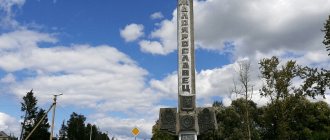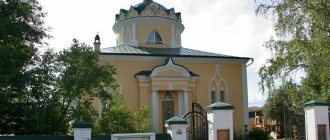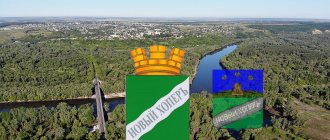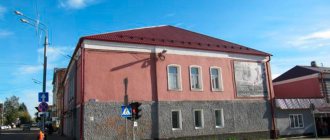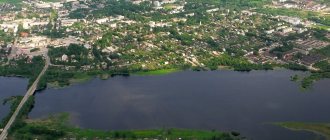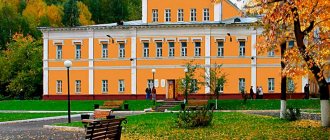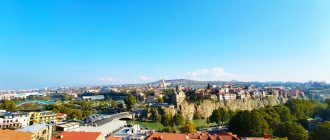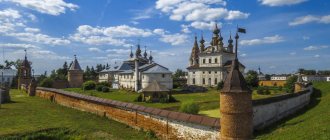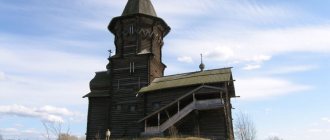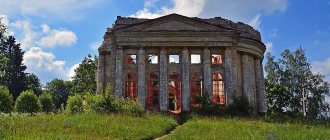The distance from Vologda is 130 km, in a northwest direction. The nearest railway station to Kirillov is Cherepovets, located 100 km away. The settlement on this site was founded in 1397, and became a city in 1776.
Its population is only 7.5 thousand people. The city includes the villages of Shortino and the village of Shumilovo, with a population of 5 thousand people.
Christian Thebaid
Venerable Kirill Belozersky. Icon of the 16th century.
It is difficult to find a place in Russia more sacred than Kirillov and its surroundings. Its glory lies in the great monasteries - Kirillo-Belozersky, Ferapontov, Goritsky, Nilo-Sorskaya Hermitage and many other small monasteries and deserts. Such a concentration of holy places, temples and monastic monasteries here made it possible to compare these places with the Christian Egyptian Thebaid.
Kirillovsky Monastery is the largest monastery in Russia. Its area is 12.7 hectares. The perimeter of the walls is about two kilometers. In its best years, up to a thousand inhabitants lived there. The relics of the founder of this Northern Lavra, the Venerable Elder Kirill, rest in the monastery. In fact, this is not even one monastery, but two - Uspensky and Ioannovsky. The latter was used as an almshouse: elderly and sick monks, the poor and crippled from various battles lived in it. In total, the monastery has 16 churches, including a wooden chapel built by St. Cyril in 1397, a wooden Church of the Deposition of the Robe from 1485, and a stone Cathedral of the Assumption of the Virgin Mary from 1497.
The grandiose fortress of the New City, erected during the time of Tsar Alexei Mikhailovich, was established as the rear residence of the Moscow sovereigns in the event of the fall of Moscow. In 1612, the Polish-Lithuanian dashing people, who devastated most of the cities of northwestern Rus', were unable to overcome the defense of the Kirillov Monastery. The monastery withstood three sieges at that time. During one of them, Kirillov’s gunners shot off the head of Pan Pesotsky, who brought his troops here, with a cannonball. After such a brilliant defense, the monastery acquired the glory of an indestructible stronghold. That is why it was decided to build such a grandiose outpost here. During the time of Peter I, when the Emperor opened a window to Europe, the monastery shared its arsenal (cannons, muskets, equipment) with the Tsar. There were enough weapons for three cities. And at the expense of the monastery, Peter’s army, which fought with the Swedes near Poltava, was equipped. In addition, prisoners were sent to the monastery; for example, at the end of the 19th century, rebellious highlanders were kept within its prison walls.
Ensemble_Kirill-Belozersky_monastery_Photo by Maria Krivosheina
The Kirillovsky Monastery was once the patronal monastery of the Valaam monastery. Ensuring the delivery to the rocky island of everything necessary for the construction of temples and services on it (brick, lime, timber, iron), the monks, in order not to go home empty, took Valaam flagstone on board. To this day, these gray slabs have been preserved in the monastery paths and stairs on Ivanovskaya Hill. In addition, the road to the temple - the tomb of St. Cyril - is lined with tombstones. These stone slabs with the names and epitaphs of mainly prominent monastery inhabitants and benefactors of the 17th century were removed from a cemetery that fell into the construction zone of the New Town fortress. The dubious use of tombstones for paving first required inscriptions to be hammered onto them, and then they were completely covered with sand. These tablets of history were discovered in the late 1990s during excavation work in the monastery, and now all the inscriptions on them have been deciphered. Also included in this path were huge stone millstones.
Fresco of the Kirillo-Belozersky Monastery. XVII century
One of the tombstones served as a step to the shrine of the relics of St. Cyril in his church. While installing the stone, the workers accidentally broke off a corner of the slab. During archaeological excavations, this fallen fragment was discovered, but when it was put back in place, it turned out that the slab had been worn down by feet by three centimeters. Such was the flow of people to the saint’s shrine. At the same time, there were three ways to worship Elder Kirill. The first is from the outside. According to long-established custom, the monastery was closed for the entire Lent. Those who did not have time to leave remained in the monastery until Easter, those who did not have time to return waited outside for Easter. At this time, pilgrims were given the opportunity to worship from afar, through a wall in which there was a cross-shaped cannon sight. From the side of the lake, kneeling near this window-cross, through its opening one could see the temple-tomb. Another approach to the shrine is a semi-arch niche between the Assumption Cathedral and the Church of St. Cyril. Pilgrims prayed there during Soviet times, when the tomb housed a museum of religion and atheism. Well, those who have the opportunity to get into the temple itself can fall to the saint’s shrine, decorated with amazing chased work in gold. The main services of the Kirillo-Belozersky Diocesan Monastery are held in the Church of St. Cyril, which is almost always open.
Transport
It’s easier to get around the city itself on foot, but it’s most convenient to explore nearby attractions - the Russian North National Park, Goritsky Resurrection Monastery or Ferapontovo - by your own car. For guests on wheels, there is parking at the Kirillo-Belozersky Monastery and at almost every decent hotel. It is not forbidden to leave the car in one of the courtyards. All parking is free.
Regular buses run around the Vologda region, but they do not run often. The fare ranges from 50-100 RUB depending on the destination. Taxi services are available to tourists; a trip around Kirillov costs about 150 RUB.
Like in a shooting gallery
Siverskoye Lake, where the monastery was originally built, is the only lake in the area that is not of glacial origin: it is a crack in the earth’s crust, and it is fed by springs. The Sviyaga River, flowing from Lake Dolgoye, flows into it. This river crosses the monastery territory, diving under the walls. The difference between the lakes was significant, and therefore the river was very swift and made it possible to install whirlpool wheels along the path of its flow, which both rotated the millstones and set the forge hammer in motion. After Siverskoye Lake was connected to the North Dvina Canal and rose significantly, the level between the lakes leveled out and the river turned into a standing reservoir. The lake today, as in ancient times, abounds in fish (smelt, bream, pike, pike perch, etc.). Being at the center of cultural tourism, the lake sometimes becomes the arena for water performances such as the European Championship in water-motor sports or a historical and cultural trip on a recreated Viking boat “from the Varangians to the Persians.” During the Great Patriotic War, on the shore of the lake there was a workshop for repairing hydroplanes and jet skis - this was convenient, since the length of the lake was about 7 km. Girls flew around the repaired cars. Flying over the monastery, which at that time was already a museum, they practiced shooting at the weather vanes of the monastery towers. It was like being at a shooting gallery - when a true hit was made, the weather vane clanged and began to rotate. The largest of them, the “trumpeting angel” on the Kazan Tower, suffered the most.
In 1662, a huge meteorite flew over the monastery with a bright glow and fell in the village of Novaya Yorga. This was perceived by many as an apocalyptic sign and gained great popularity in various regions of Russia due to the widespread expectation of the “end of the world” at that time. The rector of the local church, Father John, brought large fragments to the Kirillov Monastery. One of them weighed two pounds, and the smaller one weighed 16 pounds. The larger one was placed in the porch, and the other was built into the wall. At this time, the grandiose construction of the great sovereign fortress of Kirillo-Belozersk was completed. In 1662, the construction of the part of the wall that connects the Oblique (Guard) and Belozerskaya (Bolshaya Merezhennaya) towers was underway. The stones were examined by the abbot of the Anthony-Siysky Monastery, Theodosius, who was traveling through the Cyril Monastery to Moscow; he could tell about this “miracle” in Moscow, and the stone was demanded to where it was lost. But the one that was embedded in the wall is still here.
Photo by Vladimir Eshtokin
Future architects flock to the monastery, as if to a plein-air classroom, because here, like nowhere else, you can see in one place both temple ensembles of six centuries, and civil architecture from the works of Italian architects of the 17th century to Russian classicism of the 19th century, and unsurpassed achievements fortification art. The city has preserved a whole street of merchant mansions - Gostinodvorskaya, reminiscent of the commercial glory of the county center. These merchants were the main benefactors of the monastery in the last century of its existence. Among them were very wealthy people who traded not only in Moscow and St. Petersburg, but also abroad, for example, merchants of the first guild Simonov and Valkov. An interesting fact is that these two most influential people once quarreled and remained in irreconcilable hostility until Simonov’s death. In his will, the deceased ordered the construction of a huge two-story Gostiny Dvor on Torgovaya Square (now called the People's House) opposite Valkov's mansion, forever blocking his enemy's view of the Kirillov Monastery.
Kirillov Hotels
The hotels most often mentioned by tourists in Kirillov are “Rus” and “Lumanskaya Zavod”. Those traveling in a large group can rent a cottage. There is also a high demand for guest houses, as well as recreation centers that provide the opportunity to combine an excursion program with outdoor recreation. In this regard, the tourist village “Ekotel”, a complex located on the shore of Lake Siverskoye, has a high reputation. Guests can enjoy rural tourism, health tourism, as well as fishing and excursions to nearby attractions.
Accommodation prices range from 800 RUB per room in a guest house to 1500-2500 RUB per room in a hotel. Renting a house depends on the capacity and services provided. Prices on the page are for February 2021.
general information
The date of origin of Kirillov is considered to be 1397, when the student of Sergius of Radonezh, Kirill, founded a desert monastery here, which after 3 years turned into a monastery. Soon, a semi-independent artisan-peasant settlement was formed under the temple economy. And in the 15th century. the settlement became an outpost of the growing Moscow state on the border with the Novgorod Republic. To protect against the shilniks, stone walls were erected, turning the monastery into an impregnable fortress.
The first fortifications appeared under Ivan III (1561-1605), and their construction was completed only by the beginning of the 17th century. During the Time of Troubles, the monastery repeatedly repelled attacks by Cossack and bandit detachments and withstood 2 sieges by the Polish army. Subsequently, the city developed as a religious center, in which much attention was paid to temple construction.
Links[edit]
Notes[edit]
- ^ abcde Resolution No. 178
- ^ abc Law No. 371-OZ
- ^ abcdef Encyclopedia of Russian Cities
. Moscow: Great Russian Encyclopedia. 2003. p. 191. ISBN. 5-7107-7399-9. - ^ a b Federal State Statistics Service (2011). “All-Russian Population Census 2010. Volume 1" [All-Russian Population Census 2010, vol. 1]. All-Russian Population Census 2010 [All-Russian Population Census 2010]
. Federal State Statistics Service. - "26. The size of the permanent population of the Russian Federation by municipalities as of January 1, 2021". Federal State Statistics Service. Retrieved January 23, 2021.
- ^ abcde Law No. 1116-OD
- "On the Calculation of Time". Official Internet portal of legal information
. June 3, 2011. Retrieved January 19, 2021. - Post office. Information and computing center of OASU RPO. ( Post office
).
Search for postal service objects ( postal Search for objects
) (in Russian) - ↑
Federal State Statistics Service of Russia (May 21, 2004).
“The population of Russia, the constituent entities of the Russian Federation as part of federal districts, urban settlements, settlements, settlements is 3 thousand or more people” [Population of Russia, its federal districts, federal constituent entities, districts, urban settlements, rural settlements - administrative centers and rural settlements with a population of more than 3,000 people] (XLS). All-Russian Population Census of 2002 [All-Russian Population Census of 2002]
. - “All-Union Population Census of 1989. The current population of union and autonomous republics, autonomous regions and districts, territories, effects, urban settlements and villages. On issues of the administrative-territorial structure of the Vologda region.” Came into force on the date of official publication. Published: “Red North”, No. 124–125, July 29, 1999 (Legislative Assembly of the Vologda Region. Law No. 371-OZ of June 4, 1999 “ On issues of the administrative-territorial structure of the Vologda Region”
as amended by the Law of December 7, 2012 No. 2916-OZ “
On Amendments to the Law of the Region” On issues of the administrative-territorial structure of the Vologda Region.”
Valid from the date of official publication.). - Government of the Vologda region. Resolution No. 178 of March 1, 2010 “On approval of the register of administrative-territorial units of the Vologda region,” as amended. Resolution No. 686 of June 25, 2012 “On amendments to some Resolutions of the Regional Government.” Entered into force on March 20, 2010. Published: “Red North”, No. 29, March 20, 2010 (Government of the Vologda Region. Resolution No. 178 of March 1, 2010 “ On approval of the Register of administrative-territorial units of the Vologda Region”
as amended Resolution No. 686 of June 25, 2012 "
On amendments to various resolutions of the Regional Government
. Enters into force as of March 20, 2010). - Legislative Assembly of the Vologda Region. Law No. 1116-OZ of December 6, 2004 “On establishing the boundaries of the Kirillovsky municipal district, the boundaries and status of the municipalities included in its composition,” as amended. Law No. 2809-OZ of July 5, 2012 “On amendments to certain regional laws establishing the boundaries and status of municipalities.” Came into force 10 days from the date of official publication. Published: “Red North”, No. 242, December 11, 2004 (Legislative Assembly of the Vologda Region. Law No. 1116-OZ of December 6, 2004 “ On establishing the boundaries of the Kirillovsky municipal district, on the boundaries and status of its constituent municipalities "
as amended by the Law of July 5 No. 2809-OZ, 2012.
On amendments to various laws of the region, establishing the boundaries and status of municipalities of the region
. Valid after 10 days from the date of official publication.).
Beaches of Kirillov
Lake Siverskoye is valued for its landscapes, sandy shores and coolness - the water is perfectly refreshing on a hot day. You can swim on any shore, and the main beach, beloved by the townspeople, is located right next to the walls of the Kirillo-Belozersky Museum-Reserve. There are bridges here, and there are even boat and catamaran rentals. In addition, the bottom in this part of the lake is shallow, which is favorable for families with children. Entrance to the beach is free.
Almost every recreation center has its own beach with sun loungers and other amenities. Access to such areas is provided only to guests.
Weather
- Today
- Tomorrow
- December 16
, ThursdayMainly cloudy
+1 °C during the day -1 °C at night
- December 17
, Friday
Cloudy, light snow
-1 °C during the day -1 °C at night
- December 18
, Saturday
Mainly cloudy
-5 °C during the day -3 °C at night
- Weather for 2 weeks
It is difficult to select the best time to visit the city. Some people think it's winter. During this period, Kirillov is especially beautiful, the roads near it are in good condition (all potholes and holes are covered with ice), and there are few tourists. Others argue that it is better to go in the summer, since the icy northern winds here are very, very noticeable even in early May, and the large open spaces of the lakes do not allow the temperature to rise much even in summer.
What to bring
Traditionally, lace, linen products and blackened silver are brought from the Vologda region. The decorations and dishes from the latter are impressive in terms of detail and complexity of the plot. It’s not for nothing that local lacemakers are called artists. They made Vologda the center of Russian lace making back in the 19th century and maintain this status to this day. Another calling card of the region is Kurakino ceramics. A specialized store in Kirillov is located on the street. Preobrazhensky. The workshop is famous for its clay tiles for stoves. It is not necessary to buy a whole fireplace; bright products are sold separately and will definitely add color to the interior.
The main gastronomic attraction of the city is butter. In “tourist” stores it is sold in pots and wooden barrels - it is not a shame to give such a souvenir as a gift. In autumn, the cranberry picking season begins in the Vologda region. This berry is an unspoken symbol of the region; jam, sugar candies, marmalade and tinctures are made from it.
Vologda and Kirillov
